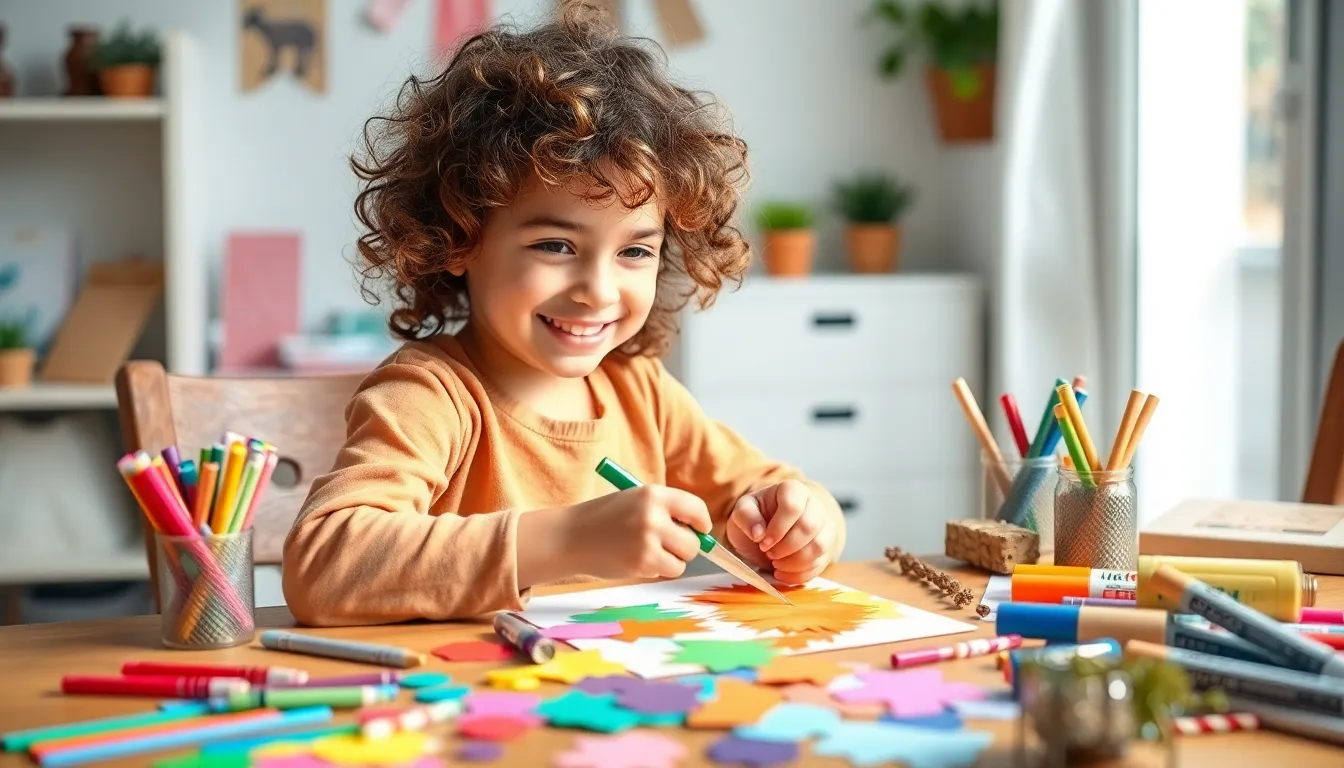Table of Contents
ToggleCrafting isn’t just for rainy days or bored kids; it’s a secret weapon in the battle for knowledge. Educational crafts blend fun with learning, turning ordinary materials into extraordinary lessons. Imagine a world where paper mache dinosaurs teach biology or homemade volcanoes erupt with chemistry. Sounds like a blast, right?
These hands-on activities not only spark creativity but also ignite a passion for learning. They keep kids engaged while sneaking in essential skills like problem-solving and critical thinking. So grab those scissors and glue sticks—it’s time to transform your living room into a mini classroom where education meets imagination. Who knew learning could be this much fun?
Overview of Educational Crafts
Educational crafts serve as effective learning tools that enhance children’s understanding of various subjects. Engaging in these hands-on projects can make complex topics in subjects like biology and chemistry more accessible. Simple materials encourage creativity while allowing children to express themselves. These activities focus on developing important skills, such as problem-solving and critical thinking.
Children experience the benefits of educational crafts in multiple ways. Each project allows them to explore concepts in a practical context, reinforcing knowledge through direct experience. Colors, shapes, and textures in crafts stimulate sensory development, enhancing cognitive function. Crafting sessions also promote fine motor skills, as children manipulate materials with their hands.
Parents can utilize educational crafts to create an imaginative learning atmosphere at home. By integrating these activities into daily routines, families foster a love for learning and exploration. Collaborating on craft projects strengthens family bonds, creating shared experiences that inspire teamwork.
Incorporating themes into crafts aids in deeper comprehension. For example, a biology project on plant life can include creating models of flowers or designing a mini-garden. These thematic projects help children grasp scientific concepts while enjoying the creative process.
Ultimately, educational crafts nurture a holistic learning approach. They offer a balance between artistic expression and academic growth. As children engage in these projects, they cultivate a passion for learning that can last a lifetime.
Benefits of Educational Crafts

Educational crafts offer numerous advantages that contribute to a child’s development. Through creative activities, children engage in a fun way to learn and solidify various concepts.
Enhancing Creativity
Educational crafts play a significant role in enhancing creativity. As children experiment with colors, shapes, and materials, they learn to express ideas and emotions through their artwork. Each project encourages innovative thinking, allowing kids to invent unique solutions to problems. Crafting in a flexible environment enables them to embrace trial and error, fostering resilience. When children transform simple supplies into imaginative creations, they boost self-confidence and discover their artistic voice. Exposure to diverse crafting techniques broadens their understanding of art and design.
Improving Motor Skills
Educational crafts also improve motor skills essential for daily tasks. Fine motor coordination develops through cutting, gluing, and assembling project components. Each action, whether threading beads or painting with a brush, strengthens hand-eye coordination. Increased dexterity results from repetitive practice, enhancing a child’s ability to manipulate objects effectively. Crafting activities naturally promote focus and concentration, as children work on intricate details. Engaging in these hands-on projects gives kids the opportunity to execute physical tasks while enjoying the learning process. Overall, crafting helps establish a strong foundation for future academic and life skills.
Types of Educational Crafts
Educational crafts come in various forms, each targeting specific learning outcomes for children. Engaging in different types of crafts helps to reinforce concepts across several subjects.
Arts and Crafts for Young Children
Arts and crafts offer an excellent introduction for young children to the world of creativity and learning. Activities include finger painting, collage making, and play dough modeling. These hands-on projects enhance fine motor skills while allowing children to express feelings and thoughts visually. Engaging with a variety of colors, shapes, and textures sparks sensory exploration essential for cognitive development. Simple crafts, such as making paper animals or nature collages, introduce early concepts of biology and the environment. Overall, these creative activities foster an inclusive atmosphere, encouraging children to experiment and explore their imaginations.
STEM-Based Educational Crafts
STEM-based educational crafts focus on integrating science, technology, engineering, and mathematics into enjoyable projects. Designing and building structures using everyday materials, like cardboard or straws, develops critical thinking and logical reasoning skills. Activities such as creating a simple circuit with batteries and light bulbs blend fun with fundamental concepts in physics. Through projects like growing crystals or building a baking soda and vinegar volcano, children engage directly with scientific principles. These crafts also promote collaborative work, encouraging teamwork and communication skills while tackling challenges and problem-solving effectively.
Tips for Implementing Educational Crafts
Implementing educational crafts effectively enhances learning experiences. Focus on key aspects like material selection and crafting space organization.
Choosing the Right Materials
Selecting age-appropriate materials maximizes engagement. Use items like paper, scissors, paints, and natural elements like leaves and twigs. Opt for non-toxic products to ensure safety during projects. Variety adds interest, encouraging children to explore different textures and colors. Incorporate reusable materials such as cardboard tubes and old magazines for eco-friendly crafting. Simple tools can enhance creativity; for instance, using glue, tape, and markers allows for diverse project possibilities. Establish a balance between structured projects and open-ended exploration to foster creativity while achieving educational goals.
Setting Up a Craft Space
Designing a dedicated craft area promotes focus and creativity. Allocate a table or a corner of a room specifically for crafts, ensuring it’s easily accessible for children. Organize supplies in clear containers or bins, so kids can quickly find what they need. Keep essentials like scissors, tape, and paints within reach. Adding a wipeable surface protects against messes, allowing for stress-free crafting. Lighting matters too; ensure the space is well-lit to enhance visibility. Consider displaying completed projects nearby, fostering a sense of achievement and inspiration for new crafts.
Educational crafts offer a unique blend of fun and learning that benefits children in numerous ways. By engaging in creative projects, kids not only grasp complex concepts but also develop essential life skills. The hands-on nature of crafting fosters a deeper understanding of various subjects while encouraging imaginative thinking.
Parents play a crucial role in this journey by integrating crafting into daily routines. This approach not only enhances the learning experience but also strengthens family bonds through shared creative moments. By prioritizing age-appropriate materials and a well-organized crafting space, families can cultivate an environment where creativity thrives.
Ultimately, educational crafts serve as an invaluable resource for nurturing a lifelong passion for learning, making education an enjoyable adventure for children.




